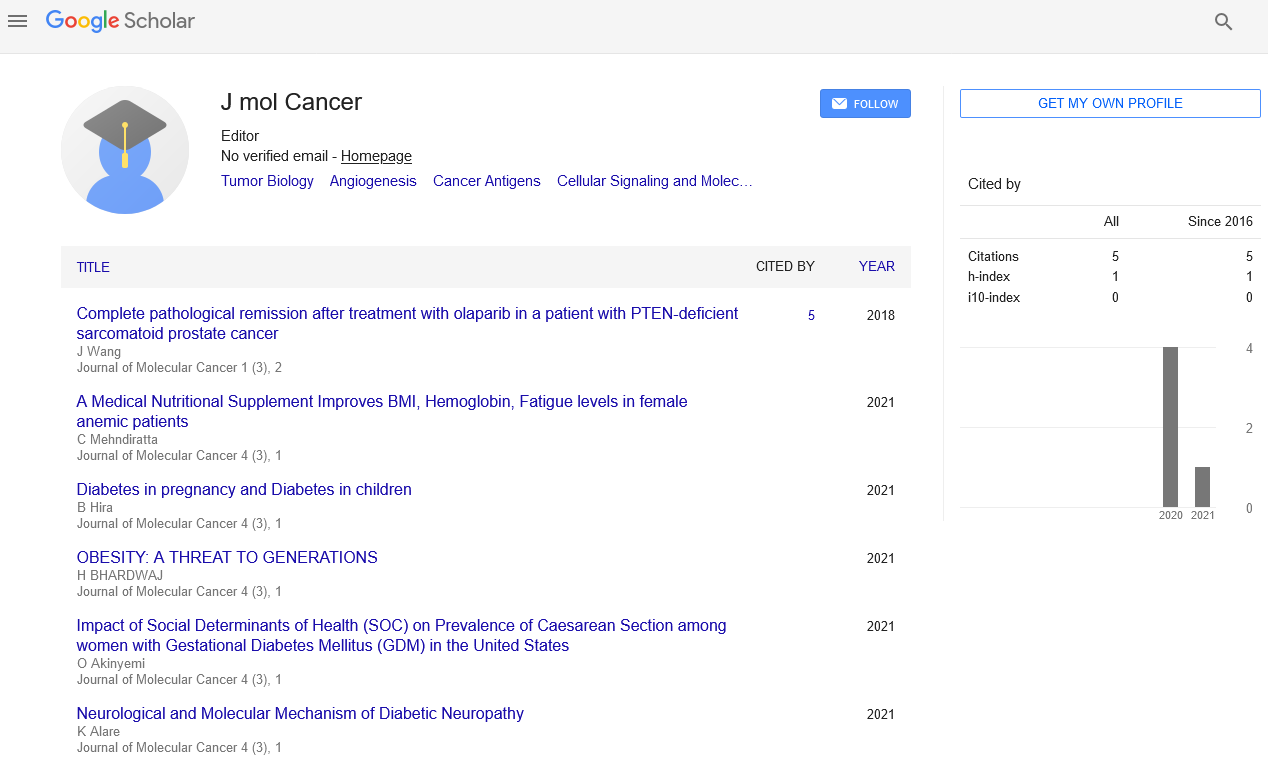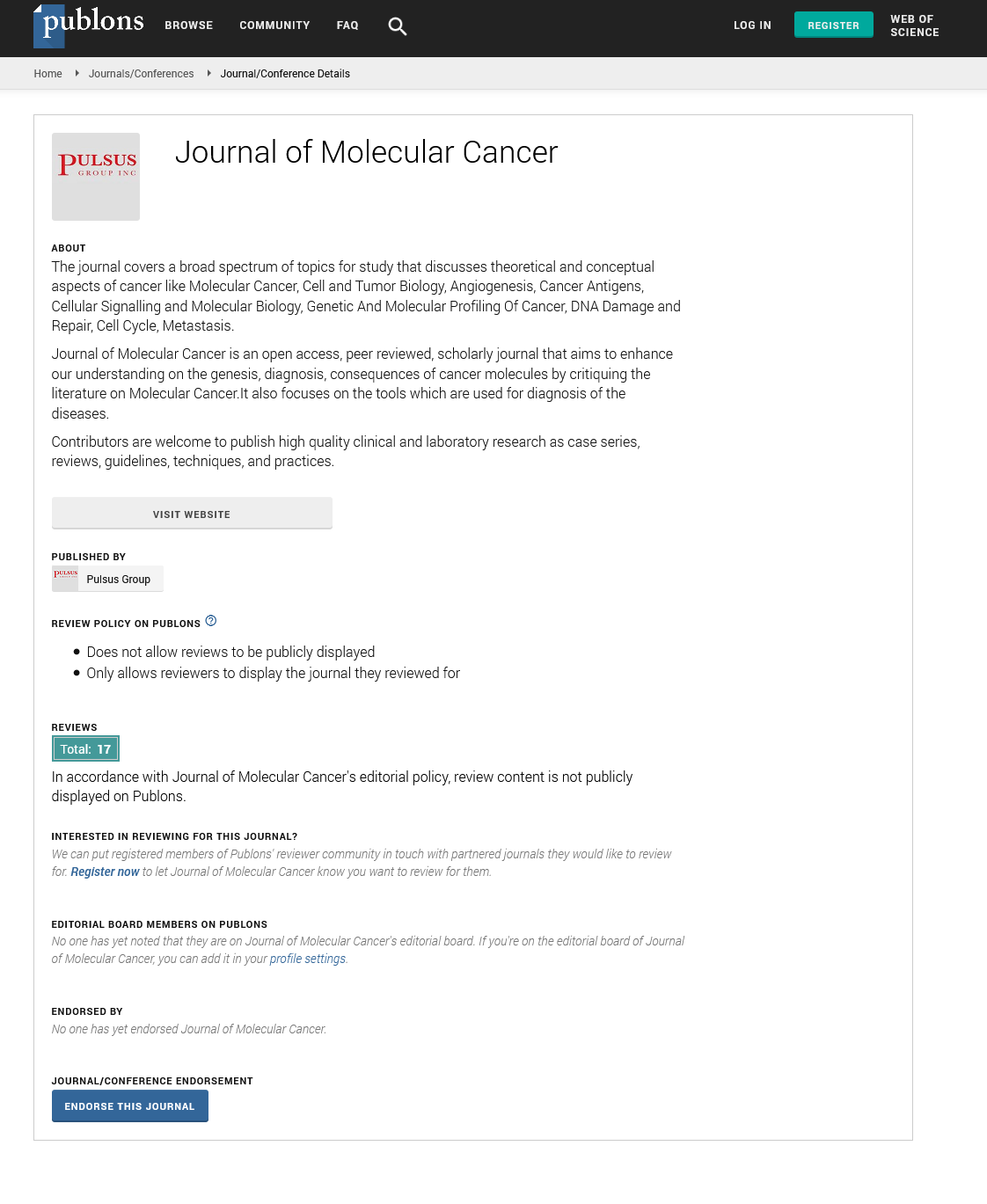Importance of the tumor board
Received: 31-Oct-2018 Accepted Date: Nov 25, 2018; Published: 15-Dec-2018
Citation: Simonsen M, Miyabe MM, Ouki HT, et al. Importance of the Tumor. J Mol Cancer. 2019;2(1):11-11.
This open-access article is distributed under the terms of the Creative Commons Attribution Non-Commercial License (CC BY-NC) (http://creativecommons.org/licenses/by-nc/4.0/), which permits reuse, distribution and reproduction of the article, provided that the original work is properly cited and the reuse is restricted to noncommercial purposes. For commercial reuse, contact reprints@pulsus.com
Keywords
Myasthenia; Gynecologic Oncology
Thank you very much for the opportunity to make comments on my previous publication entitled “Myasthenia as a paraneoplastic manifestation of ovarian cancer” [1]. It is an opportunity for me to give some information regarding patient outcomes and decision-making about this rare manifestation of the disease. I would like to emphasize the importance of the tumor board decision on the chemotherapy choice and therapeutic strategies adopted.
The tumor board has an important role in improving the quality of patient care [2,3] and progressively integrating more specialties [4], as well as molecular medicine [5], which could be included in the meetings. Tumor boards in gynecologic oncology have already been described in some previous studies and the potential to change the treatment plan reaches more than 40% of the discussed cases [3]. Major changes regarding the treatment plan include change of modality (radiotherapy/chemotherapy/surgery) or addition of them and reach 10% of the cases [3]. It is important to review the images, tumor stage, pathologic reports, as well as the available therapeutic options. Each case review normally takes 10 minutes, according to a previous publication [3]. At our institution, each case takes 20 minutes because a mini literature review normally is presented in conjunction with the cases.
A multidisciplinary approach helps to understand the potential effect of each field on global patient health and to improve what is suitable. Discussions with oncologists, radiologists and pathologists optimize the treatment [6]. Other specialists, such as psychologists, nutritionists and physiotherapists should also participate in the regular meetings.
The gynecologic tumor boards frequently discuss ovarian cases in meetings and possibly the discussion could improve the discouraging prognosis related to this neoplasm [6-8].
Each case normally has important issues regarding the pathologic report, as well as alternative performance improvement and therapeutic options [6]. Most ovarian cases at our institution are selected for discussion by tumor boards and often the therapeutic plan is changed. There are two main possible approaches for advanced stage ovarian cancer: primary debulking surgery or interval debulking surgery, after 3 cycles of chemotherapy [9,10]. As described by the National Comprehensive Cancer Network (NCCN) [11], we normally offer interval debulking surgery for patients with worse performance or, in high-risk cases, for non-optimal cytoreduction. The poor performance related to a myasthenic crisis was the reason for starting treatment with chemotherapy. According to the tumor board decision, we selected cyclophosphamide because of its qualities in controlling the myasthenic crisis and also treating ovarian cancer. The change to carboplatin AUC5 D1 and paclitaxel 175 mg/m2 D1 every 21 days also contributed to the good response in the patient. We believe that the good patient performance after some cycles allowed us to make an interval R0 cytoreduction.
Unfortunately, eight months after the end of the treatment, and after submission of the original paper, the patient developed a disseminated peritoneal recurrence. This pattern of recurrence is frequent among patients with aggressive manifestation of ovarian neoplasms [12]. The amount of disease was not suitable for a secondary debulking surgery. Our group opted for the introduction of carboplatin AUC4 D1, gencitabine 1000 mg/m2 D1, D8 plus bevacizumab 15 mg/kg D1 every 21 days. Choosing platin-based chemotherapy for recurrent ovarian cancer is suitable for cases with at least 6 months of disease-free survival [13]. All efforts should be made to improve the multidisciplinary approach, regardless of the aggressiveness and recurrent pattern of the ovarian neoplasm. Integrating other specialties effectively changes the therapeutic choices and potentially improves treatment.
REFERENCES
- Simonsen M, Miyabe MM, Ouki HT, et al. Myasthenia as a paraneoplastic manifestation of ovarian Cancer. Gynecol Oncol Rep. 2018;25:35-6.
- Santoso JT, Schwertner B, Coleman RL, et al. Tumor board in gynecologic oncology. Int J Gynecol Cancer. 2004;14:206-9.
- Lee B, Kim K, Choi JY, et al. Efficacy of the multidisciplinary tumor board conference in gynecologic oncology: A prospective study. Medicine (Baltimore). 2017;96:e8089.
- Lesslie M, Parikh JR. Implementing a Multidisciplinary Tumor Board in the Community Practice Setting. Diagnostics (Basel). 2017;7:55.
- Harada S, Arend R, Dai Q, et al. Implementation and utilization of the molecular tumor board to guide precision medicine. Oncotarget. 2017;8:57845-54.
- Greer HO, Frederick PJ, Falls NM, et al. Impact of a weekly multidisciplinary tumor board conference on the management of women with gynecologic malignancies. Int J Gynecol Cancer. 2010;20:1321-5.
- Knaus JV, Bugno T, Nathan D, et al. Integrative tumor board: recurrence of ovarian cancer. Integr Cancer Ther. 2002;1:392-416.
- Cohen P, Tan AL, Penman A. The multidisciplinary tumor conference in gynecologic oncology--does it alter management? Int J Gynecol Cancer. 2009;19:1470-2.
- Vergote I, Trope CG, Amant F, et al. Neoadjuvant chemotherapy or primary surgery in stage IIIC or IV ovarian cancer. N Engl J Med. 2010;363:943-53.
- Chi DS, Musa F, Dao F, et al. An analysis of patients with bulky advanced stage ovarian, tubal, and peritoneal carcinoma treated with primary debulking surgery (PDS) during an identical time period as the randomized EORTC-NCIC trial of PDS vs neoadjuvant chemotherapy (NACT). Gynecol Oncol. 2012;124:10-4.
- Alvarez DKASCPRD, Behbakht JNB-GLBK. Ovarian Cancer NCCN Guidelines Version 2.2018 National Comprehensive Cancer Network. 2018.
- Harter P, Sehouli J, Reuss A, et al. Prospective validation study of a predictive score for operability of recurrent ovarian cancer: the Multicenter Intergroup Study DESKTOP II. A project of the AGO Kommission OVAR, AGO Study Group, NOGGO, AGO-Austria, and MITO. Int J Gynecol Cancer. 2011;21:289-95.
- Coleman RL, Brady MF, Herzog TJ, et al. Bevacizumab and paclitaxel-carboplatin chemotherapy and secondary cytoreduction in recurrent, platinum-sensitive ovarian cancer (NRG Oncology/Gynecologic Oncology Group study GOG-0213): a multicentre, openlabel, randomised, phase 3 trial. Lancet Oncol. 2017;18:779-91.






